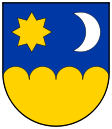
Ipolyság

Ipolyság (Sahy, Eipelschlag) is right on the Slovakian-Hungarian border, not far away from the castle of Drégely. It is located in the valley of the Ipoly River, in the Upper Lands /Horná Zem / Felvidék, in Slovakia. It is famous for its fortified monastery which played a role in guarding the Borderland during the Ottoman wars, especially when Drégely Castle fell.

Read more about Drégely Castle here:
https://www.hungarianottomanwars.com/kingdom-of-hungary/dregely/
and read my dramatized short historical story about it, too:

The first written mention of Ipolyság (or Ság) is from 1237 in a document of King Béla IV under the name Saag, when Bán Martin of Hont-Pázmány founded a Premonstratensian monastery there. The Mongols burned it in 1242.

The monastery was dedicated to the Virgin Mary and was called Praepositura Beatae Mariae de Saagh in 1255. King Béla had a stone bridge built over the Ipoly River in 1266 and gifted the tax-collecting rights to the monks. Fegyverneki Ferenc was a chief priest who had worked there for 30 years in the 14th century, he was a renowned man all over Europe. He was a very open-minded priest who had done a lot to introduce reforms in the Catholic church.
It became a small town in the 14th century and had a right to hold a market in 1405. King Zsigmond gave the “right of the sword” to the town in 1407 so they were allowed to execute criminals. The first fortifications are from the 15th century. Some noblemen in the neighborhood got jealous of the wealth of the monastery and the four sons of Lord Gyarmati Balázs chased away Dean Bálint in 1444 and built a castle on his behalf. The monastery was robbed in 1447 by the Czech mercenaries of Lévai Cseh László.

Then, Jan Giskra took it and reinforced its walls in 1451. It was Governor Hunyadi János who drove him out some years later. We know that the Church was still debating in the court with the Lévai-Cseh family in 1511 over the stolen treasures but there is no information on whether they were returned or not.

The king had the monastery reinforced in 1546 as the new chain of castles was set up against the Ottoman threat. The smaller palaces and monasteries had to be pulled down and the others were reinforced during this work, done by General Salm and Bishop Pál Várady. Ipolyság was reinforced because important trade routes passed through its bridge towards the mining towns of the Upper Lands. When the Turks took Esztergom, Vác, and Buda castles, they wanted to reach their hands after the mining towns. The first captain of Ság (Ipolyság) was no one else than the famous Hungarian duelist and warrior, Thury György. When Léva was under siege, he was hurrying there and defeated the raiders at Szalka who were going home towards Esztergom.
Jakusitsh Ferenc became the next captain of Ság in 1550. Interestingly, there were twice as many men in Ság as in Drégely castle in 1550, namely 76 riders and 50 footmen. The walls withstood the Ottomans’ siege in 1550 but it fell two years later, it went into the Turks’ hands in 1552 for a few days, after the fall of Drégely. The defenders chose to burn the castle and flee, instead of suffering a heroic death as Lord Szondy György did with his 146 men in Drégely Castle. The monks could miraculously save all the documents of the monastery because they carried the boxes to Garamszentbenedek.

When Pasha Ali and his 12,000 men turned towards the Mining Towns District, King Ferdinand sent the proud General Teuffel Erasmus against them. (He was nicknamed Devil Matthias / Ördög Mátyás, among the Hungarians due to his character). He had 10,000 men who finally engaged in battle with Ali at Palást, in the narrow valley of the Korpona stream, and after two days’ fight, they were shamefully defeated.
The Bishop of Vác, Ágoston Sbardellatti fell in the battle, he was the last Hungarian high priest after the Battle of Mohács (1526) who died with a sword in his hand. Teuffel, who had been afraid to aid either Drégely or Ság with his 10,000-strong-army, was taken to Istanbul and he was impaled in public there.

The Ottomans occupied the greater part of the County so Ság came under their rule for three years. When they were gone, the Christians pulled down the walls in 1595 because they didn’t want the Turks to have the fort in case of taking it again. Their guess was right because the enemy did take it and Ipolyság was known as “Şefradi” between 1626-1685.

We must mention Prince Bethlen Gábor, the Transylvanian ruler who was fighting General Wallenstein in 1626 near Ság. Szecsei András, the Reformed preacher was working in the town in 1670 and was taken as a slave to row galleys. The plague visited the town in 1600, 1632, and very severely in 1663. It was also an Ottoman sanjak center in “Uyvar eyalet” between 1663 and 1685. The Jesuits got the monastery in 1688 from Emperor Leopold I and rebuilt it. Prince Rákóczi Ferenc II received the Transylvanians’ delegation in the monastery in 1704 which brought him the princely title from Gyulafehérvár.

Dear Readers, I can only make this content available through small donations or by selling my books or T-shirts:
Please, feel free to support me with a coffee here:
You can check out my books on Amazon or Draft2Digital, they are available in hardcover, paperback, or ebook:
https://www.amazon.com/dp/198020490X or at https://books2read.com/b/boYd81

My work can also be followed and supported on Patreon: Become a Patron!http://Become a Patron!
[wpedon id=”9140″]

https://hungarianottomanwars.myspreadshop.com/all




















